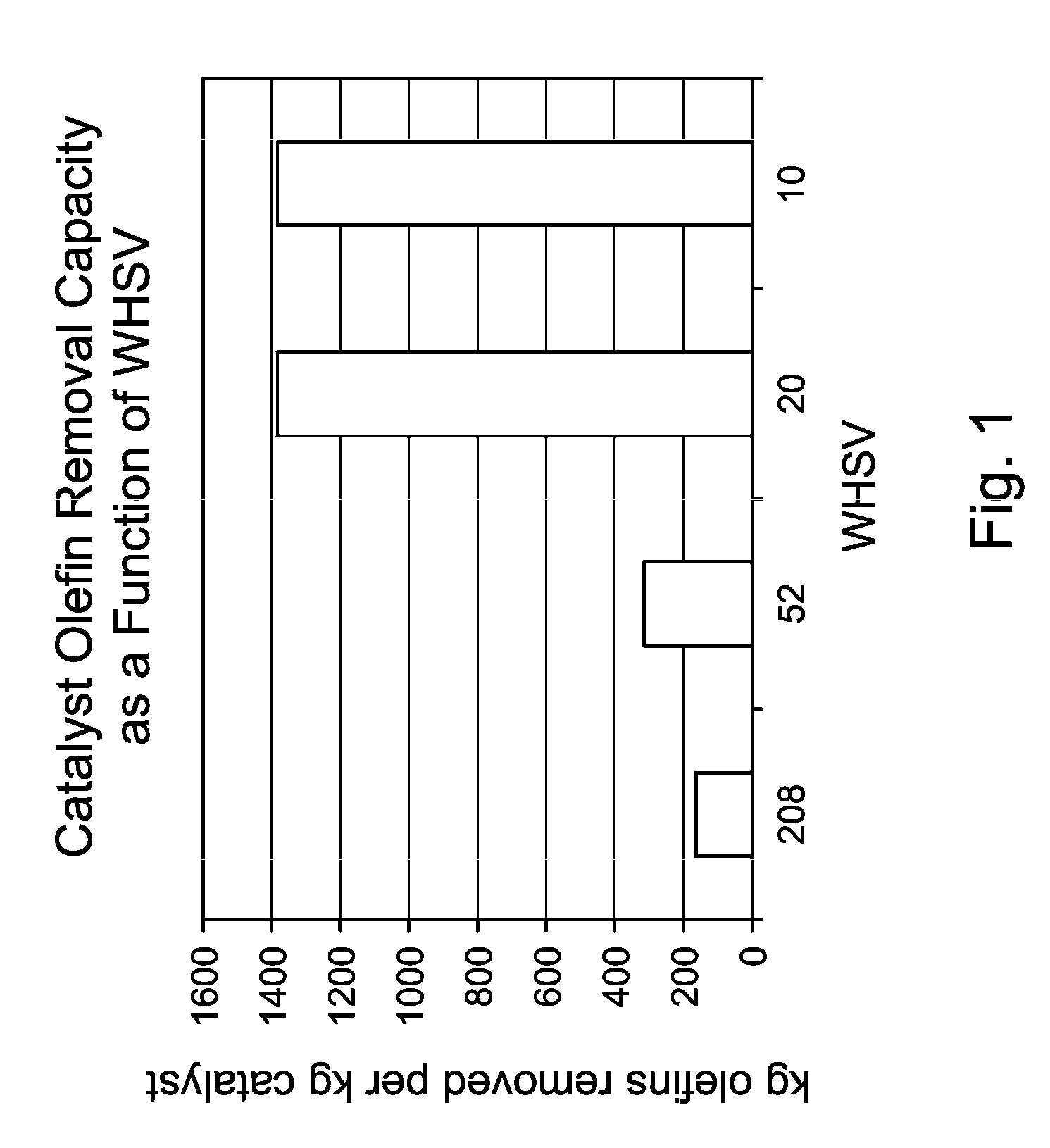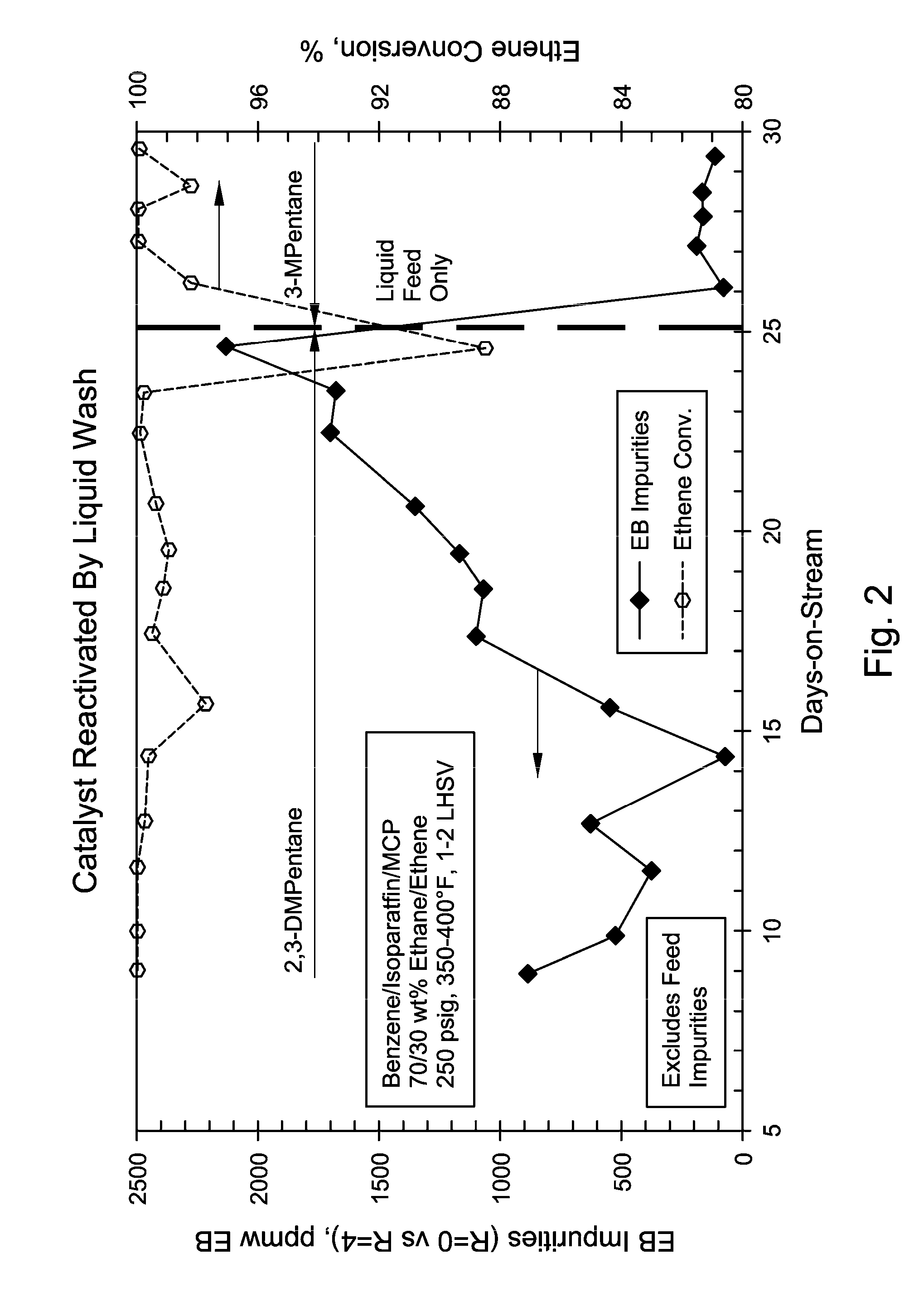Removal of bromine index contaminants from aromatic streams
a technology of bromine index and aromatic streams, which is applied in the direction of organic chemistry, chemistry apparatus and processes, and refining with metals, etc., can solve the problems of unsatisfactory side reactions, increased contaminants in the reformate derived streams, and generalization of the zeolites used for this purpose, so as to improve the removal of impurities, increase the yield of products, and increase cycle length
- Summary
- Abstract
- Description
- Claims
- Application Information
AI Technical Summary
Benefits of technology
Problems solved by technology
Method used
Image
Examples
example 2
[0049]The same xylenes plant heavy reformate feedstock with a BI of 1000 (1.5 lbs olefins per bbl) used in comparative example 1 is treated over selfbound MCM-22 catalyst at starting conditions of 10, 20, 52, and 208 LHSV and 210° C. The BI of the xylenes produced from the reactor effluent is monitored with time on stream. When the BI of the xylenes exceeded 10 temperature was raised by 10° C. increments until the reactor temperature reached 250° C. The run continued at 250° C. until the xylenes BI reached the 20 ppm specification. The amount of olefins removed per cycle as a function of LHSV is plotted in FIG. 1. The experiments prove that selfbound MCM-22 surprisingly can operate in a WHSV and temperature window outside of the operating conditions traditionally used to remove olefins from heavy reformates. The experiments surprisingly prove that selfbound MCM-22 can operate up to 20 WHSV without showing any loss in olefin removal capacity.
example 3
[0050]The reaction of benzene with ethylene is used to model the reaction of C6+ iso-olefins that occur in aromatics plant treatment units. Liquid feedstocks were prepared from benzene, 2-methyl-pentane, 2,3 dimethylbutane, and methylcyclopentane. The feedstock compositions are provided in Table 1. These feedstocks were blended with ethylene at mole ratios of ethylene to benzene of 0.5:1 and 1:1. The blended feedstock was processed at 2-10 WHSV, 250 psig, >98% ethylene conversion, and 350-400° F. (149-204° C.). The catalyst was an MCM-22 family molecular sieve.
[0051]
TABLE 1Feed CompositionsModel Isoparaffin2,3-Dimethylpentane3-MethylpentaneMidas Number95-13716, -1775495-29749Nominal Composition, wt %3-Methylpentane—49.5Methylcyclopentane1.01.0Benzene49.549.52,3-Dimethylpentane49.5—Composition (GC11), wt %2-Methylpentane—0.0473-Methylpentane—43.791N-Hexane0.0080.055Methylcyclopentane0.9230.9392,2-Dimethylpentane0.079—Benzene51.71855.1633,3-Dimethylpentane0.020—Cyclohexane0.012—2,3-Di...
example 5
[0055]A combination of fresh and recycled xylenes plant feedstock is flowed at 0.1 LHSV and 180° C. across a catalyst system comprising 60 vol % MCM-22 catalyst on top of 40 vol % clay catalyst in order to remove water from the catalyst / clay system. The feedstock is produced by distilling the liquid product obtained from a refinery CCR to obtain a C8+ heavy reformate. The feedstock has a BI ranging from 750 to 1500 and contains 50 wt % C8 aromatics. Water is stripped from the product. After 3 days on stream the water in the reactor effluent drops below 1000 ppm. The main feedstock flow is then switched to the newly dried reactor. The fresh, dry commercial catalyst is now operating at 5 LHSV and 210° C. The reactor is equipped with a system to recycle product. The recycle system is turned on at a rate of 15 LHSV. 3 volumes of <200 BI reactor product are mixed with one volume of 1000 BI fresh feed. The combined fresh plus recycle feed enters the reactor with a BI near 400 and passes a...
PUM
| Property | Measurement | Unit |
|---|---|---|
| temperature | aaaaa | aaaaa |
| temperature | aaaaa | aaaaa |
| temperature | aaaaa | aaaaa |
Abstract
Description
Claims
Application Information
 Login to View More
Login to View More - R&D
- Intellectual Property
- Life Sciences
- Materials
- Tech Scout
- Unparalleled Data Quality
- Higher Quality Content
- 60% Fewer Hallucinations
Browse by: Latest US Patents, China's latest patents, Technical Efficacy Thesaurus, Application Domain, Technology Topic, Popular Technical Reports.
© 2025 PatSnap. All rights reserved.Legal|Privacy policy|Modern Slavery Act Transparency Statement|Sitemap|About US| Contact US: help@patsnap.com


